The Series 43 from Omnichrome (later acquired by Melles Griot and re-branded as the Series 643) is an argon/krypton ion laser capable of several mW of output power and can potentially output several different visible wavelengths at once (multiline). The ~568nm wavelength seems to be most prominent in this unit, but this can vary greatly based on system design and operating parameters. Argon/Krypton ion lasers are quite uncommon to find in working condition nowadays and are highly desirable among laser enthusiasts. Used argon ion lasers are not difficult or very expensive to obtain, even in working condition. Krypton ion lasers are another story. If you can find one in working condition, it will likely be expensive! Both argon ion and krypton ion lasers follow the same operating principles. The main differences include the gas or gas mixture used within the tube, and the optics. Different gases and optics result in different wavelengths of light output. Many krypton ion lasers can actually be converted to "white light" lasers by changing out the optics. This is very desirable, but generally is an expensive and risky undertaking. The power supply technology and overall laser head structure remains the same. Pretty much any Ion laser is incredibly inefficient, they can draw anywhere from 1000 watts to several kilowatts and generally produce anywhere from 50-200mW of output power (smaller air-cooled units). The power supply used in conjunction with this Omnichrome Series 43 (Melles Griot 643) laser head is the model 171 ion laser power supply. There are 3 potential power supplies that can be used with the Melles Griot series 543 and 643 ion laser heads. The model 171 and 176 power supplies use a DC cathode filament supply. The model 170 power supply uses an AC cathode filament supply.
Laser Head
The laser head is quite large like other ion lasers and has a cylindrical piece on top where the ventilation tube is to be attached. The diameter is about the same as a standard dryer duct. The power supply umbilical and fan connectors are on the top of the laser head. The hour counter is on the other side.

After the metal cover is removed, we can see the inside of the laser head. Air is drawn in from the vents on the side of the casing, and through the metal fins to cool the laser tube. A separate fan module and duct work to essentially "suck" air through the laser head and exhaust it elsewhere.
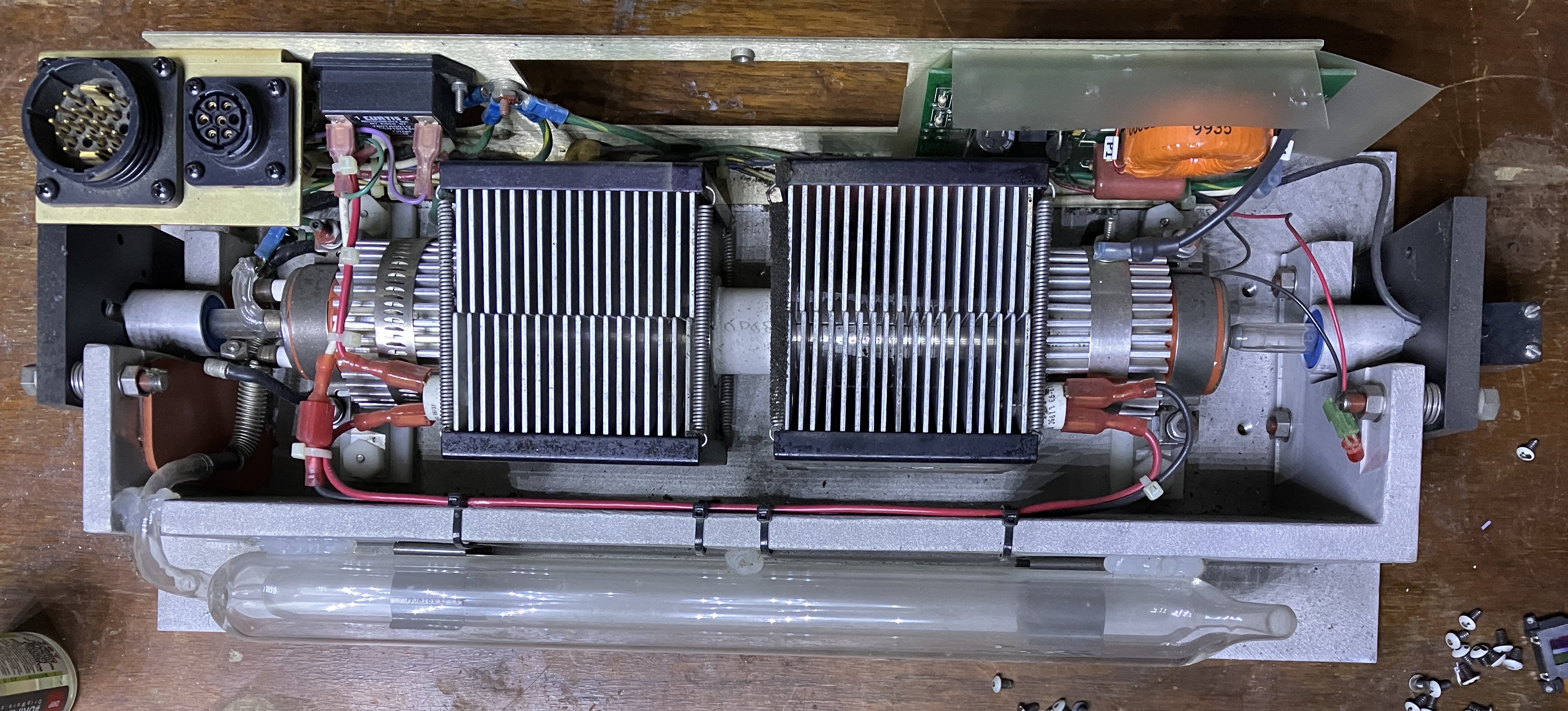
This glass tube assembly is the gas reservoir. It connects directly to the laser tube and is extremely delicate. Abrupt shocks or impacts against this side of the casing of the laser head can render it completely unusable.
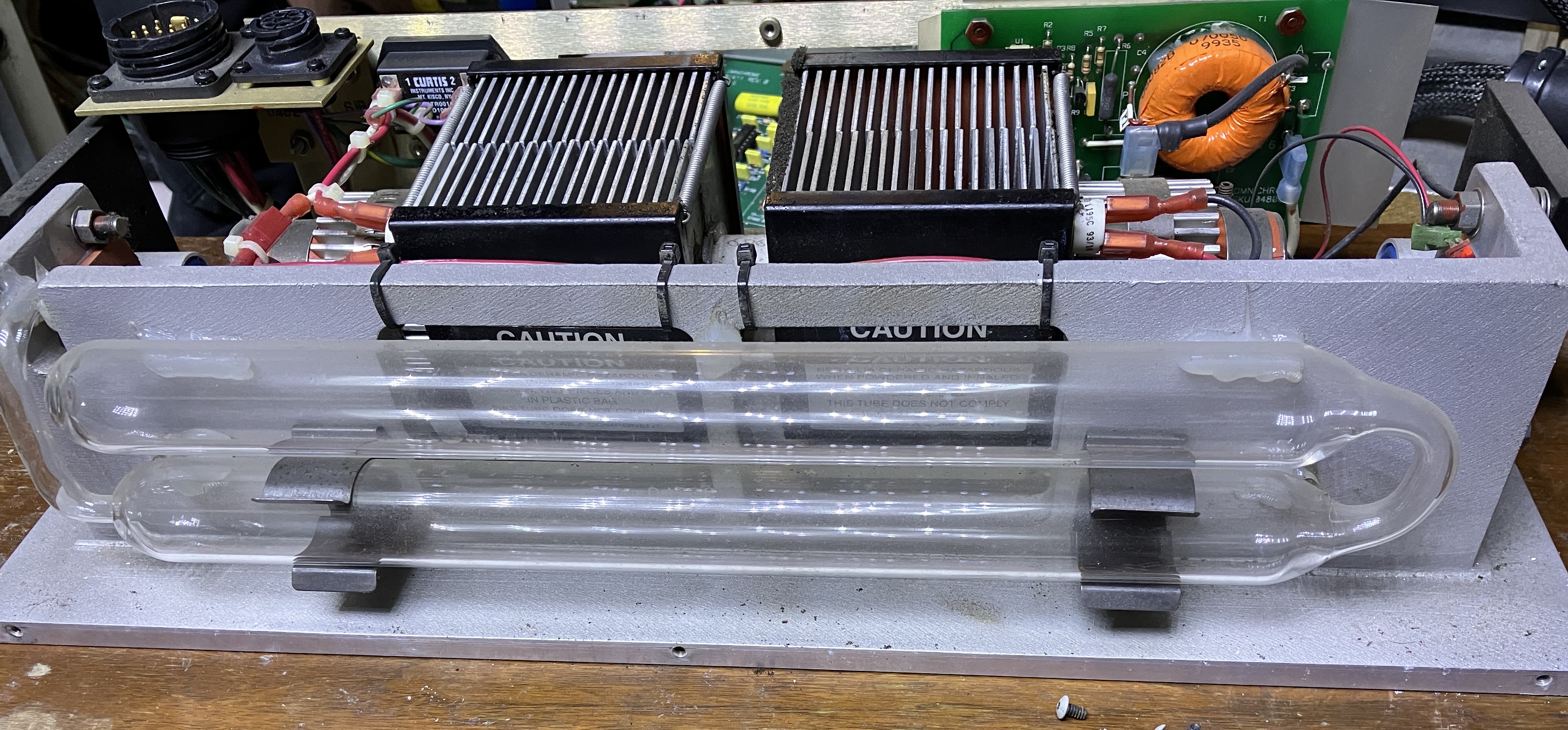
On the left side inside the laser head, we can see the two connectors that lead back to the power supply and blower fan module. This is also the cathode side of the tube. Other notable components include the Curtis hour counter, thermal cutoff switch (white cylinder with two spade connectors), and the angled glass fill port on the tube.
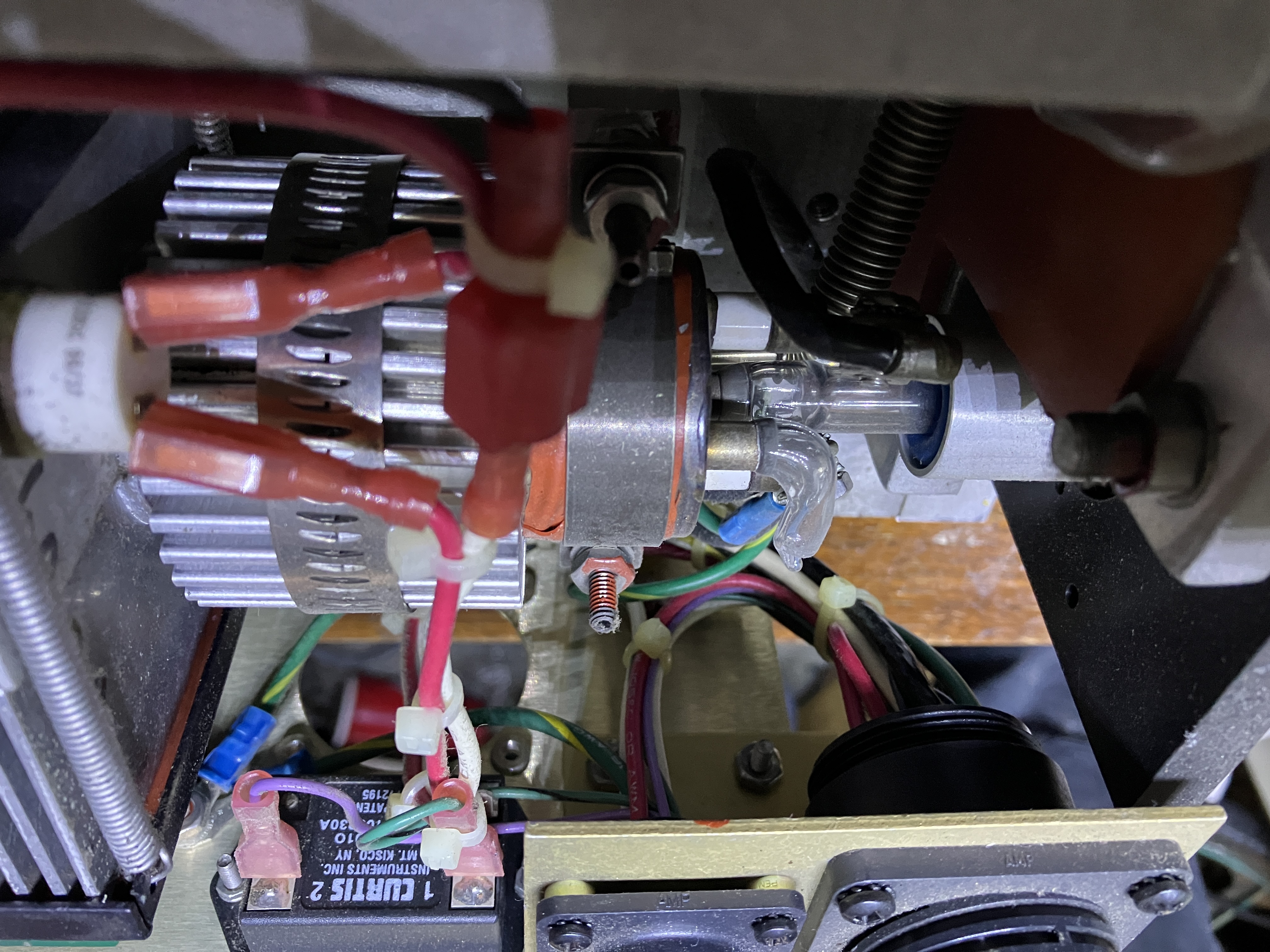
On the right side of the laser head, there is a small circuit board with the anode connection to the tube. The anode connection goes to a hose clamp with a spade lug connector, the hose clamp is securely fastening to the metal heatsink that surrounds the tube. This circuit board also has connections to the laser emission LED and photodiode located at the front of the laser head.

This is the high reflector (HR) assembly with adjustment screws located at the rear of the laser head. The 3 large nuts secure this panel to the interior structure which provides mechanical rigidity and stability to keep the laser head in alignment and protect the tube from torque.

On the front of the laser head, this is the laser output aperture. Mounted to the top, located within the small black piece, is the photodiode. This takes a sample measurement of laser output power and feeds it back to the power supply for monitoring and control. The large nuts connect to the same internal structure that was mentioned earlier.
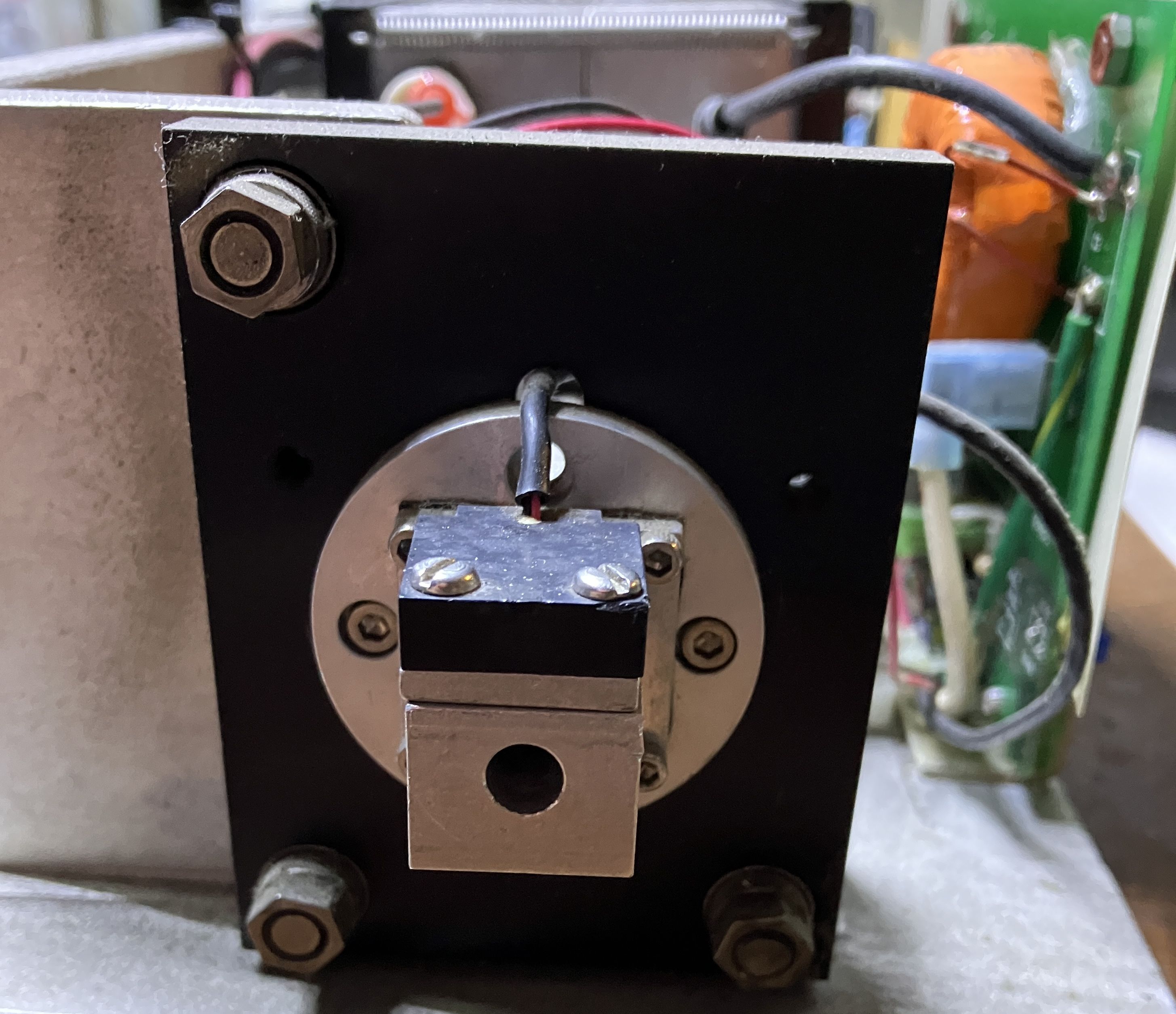
Since ion lasers generate an enormous amount of heat while running, it is not a great idea to run them without their OEM (or sufficient) cooling solution in place. Smaller ion lasers like this one rely on forced air cooling, but larger ion lasers require water cooling. We placed a large fan over the heatsinks to run this unit with the cover removed, without damaging it. Still, we would not recommend doing this for very long. Much like a rack-mounted server, the OEM cooling solution is designed specifically to cool the components to specification. The removal of any covers or components could disrupt the airflow and cause the system to be insufficiently cooled.

The image below is not color-corrected, but we decided to include since the glowing "green" anode side of the tube looks pretty neat!

Here is an image of the laser "dot" on a white background. It's not as bright in person as it looks, but is plenty sufficient for an old and temperamental laser!
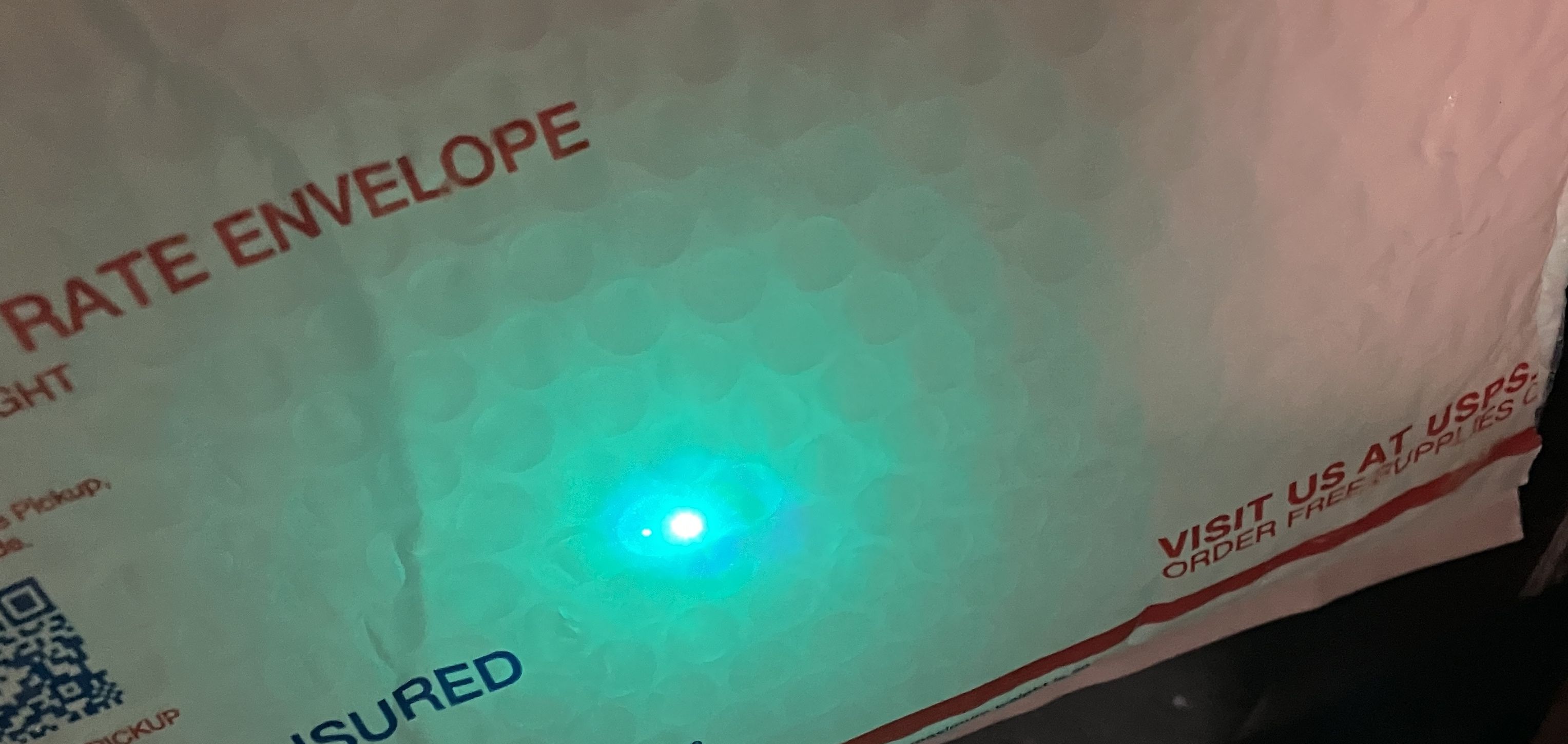
Placing a diffraction grating in the beam path exposes some additional wavelengths being generated by the laser tube!
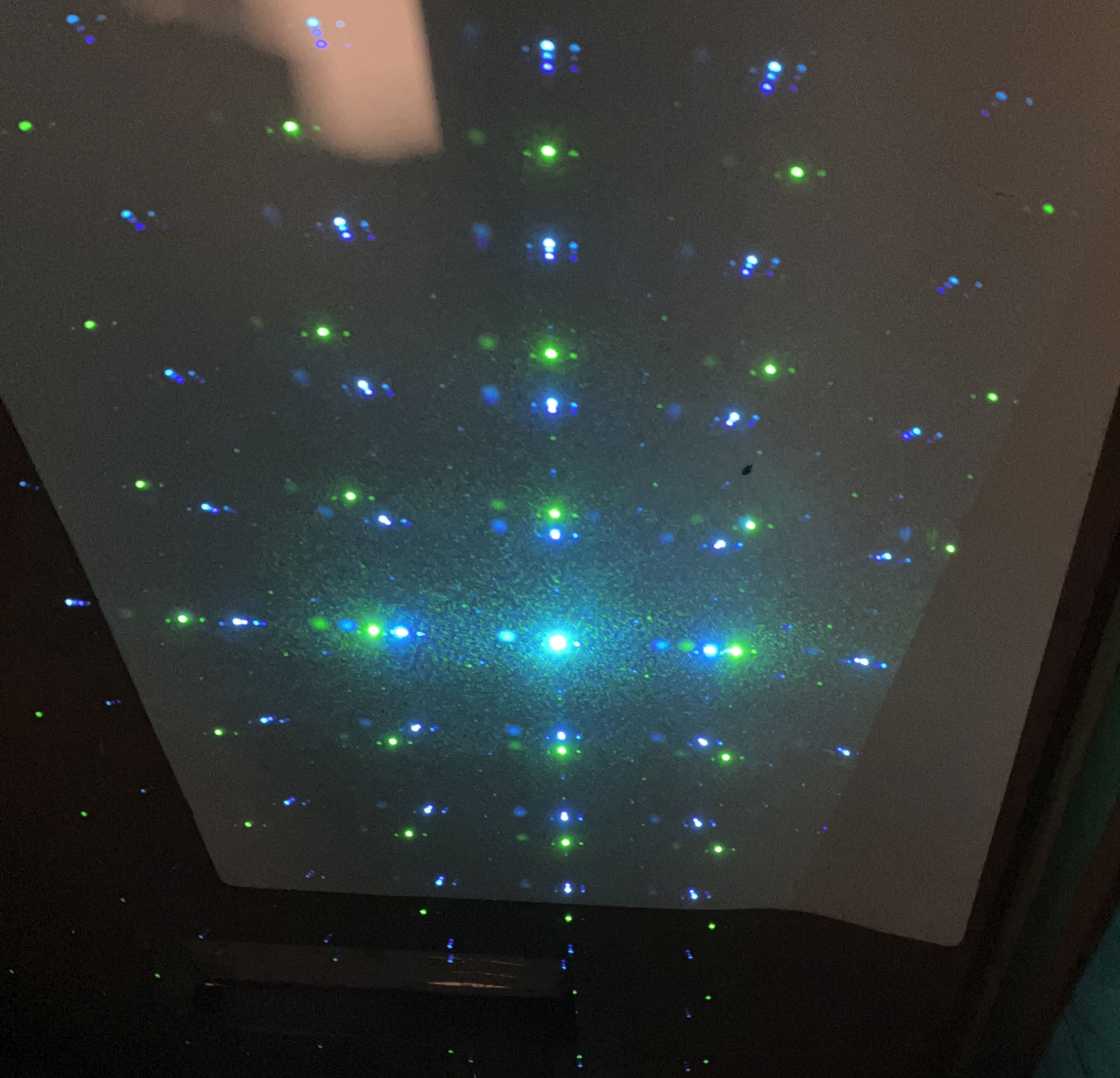
Power Supply
The Omnichrome model 171 ion laser power supply is not much different than most air cooled ion laser power supplies. They also share many similarities with more modern ion laser power supplies from Melles Griot. This is not surprising as Melles Griot acquired Omnichrome a while back. On the front of the power supply, we have some basic connections and controls. An AC power switch is used to enable AC power from the socket on the back. The potentiometer labeled "LEVEL" adjusts laser output based on either tube current or output power measured by the photodiode. The key switch is used to actually enable the laser. It must be briefly turned to the "START" position and then left on to run the laser, much like a car ignition switch. The laser head connects to the large twist-lock connector labeled "HEAD". The DB-25 connector labeled "REMOTE" is used for monitoring and controlling the laser system. It also provides the interlock connections necessary to enable laser output. The following connections must be made at the REMOTE connector for the laser to operate: PIN 1 CONNECTED TO PIN 3, PIN 19 CONNECTED TO PIN 21.

On the rear of the power supply, we can see the information labels, which indicate that this unit was manufactured in 1995. Additionally, there is a cooling fan and an IEC 20 A AC input connector.
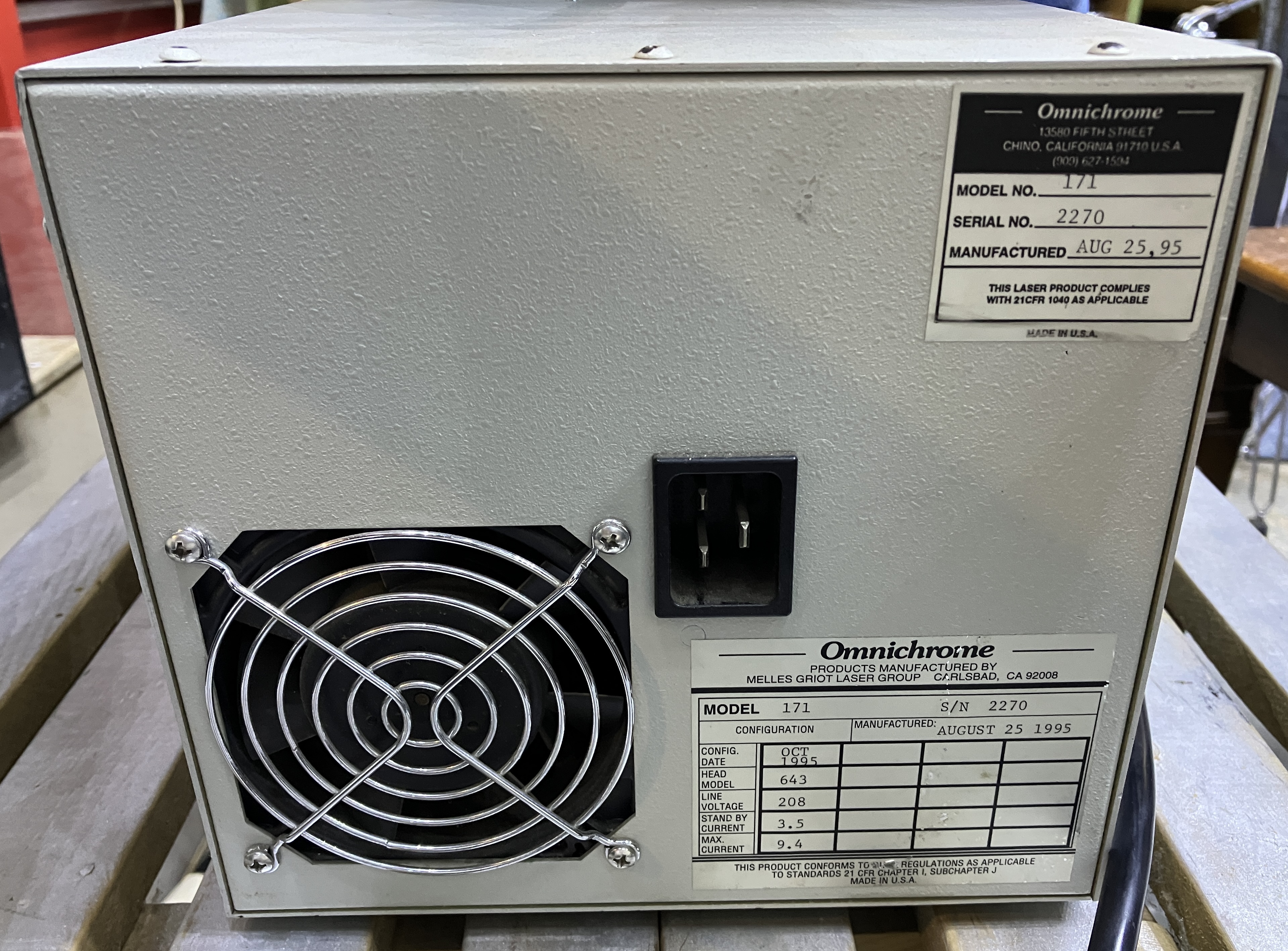
These ion laser power supplies are quite complicated and "meaty". Aside from all of the control and monitoring logic, they supply the high voltage and current needed to strike and run the ion laser tube. Be extremely careful when working on ion laser power supplies as they are some of the most dangerous. On the left side is the cooling fan and AC input filtering section (metal case with brown and blue wires exiting). A large heatsink partially obscures the main circuit board. There is a smaller circuit board card that inserts into the 3 dual-row pin connectors, it was removed in this photo. On the right side we can see some of the high current connections (spade lug connectors and heavy-gauge wiring) as well as a bridge rectifier mounted to a heatsink (top right).
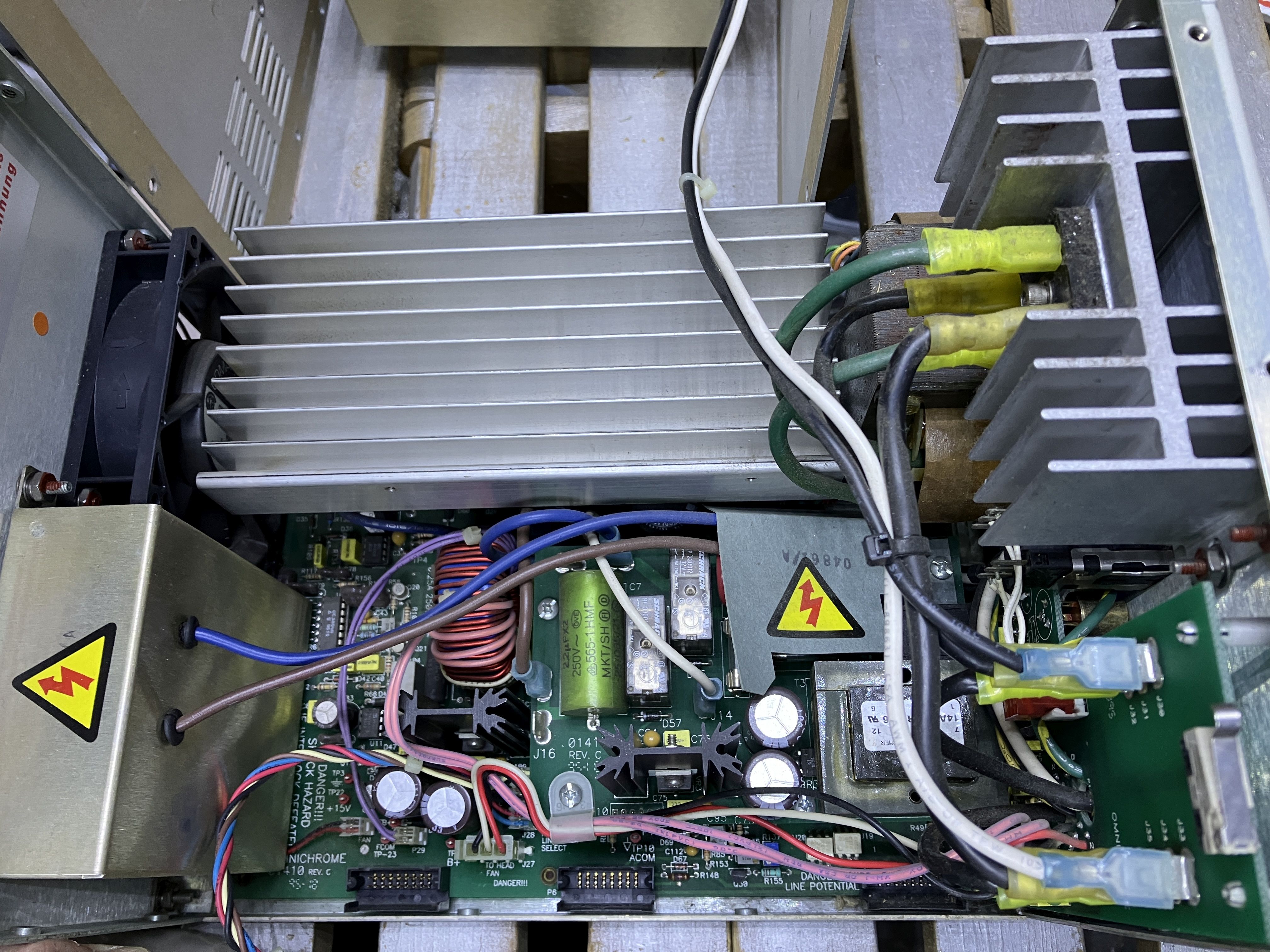
On this board there is some logic related to laser control and operation as well as a pretty large toroidal core transformer. It was an odd choice to mount a heavy and bulky transformer to a thin circuit board. This board connects to the main circuit board in a perpendicular arrangement using the 3 dual-row pin connectors. It is also secured to the side of the case by some screws. There are several potentiometers and test points on this board, most of which are clearly labeled. That was a nice touch and is uncommon to see.

As Photonicinduction would say: there are 3 "big and juicy" capacitors secured to the top case panel and connected to the main circuit board. These are capable of storing a significant amount of energy, please use caution when working on systems like this.
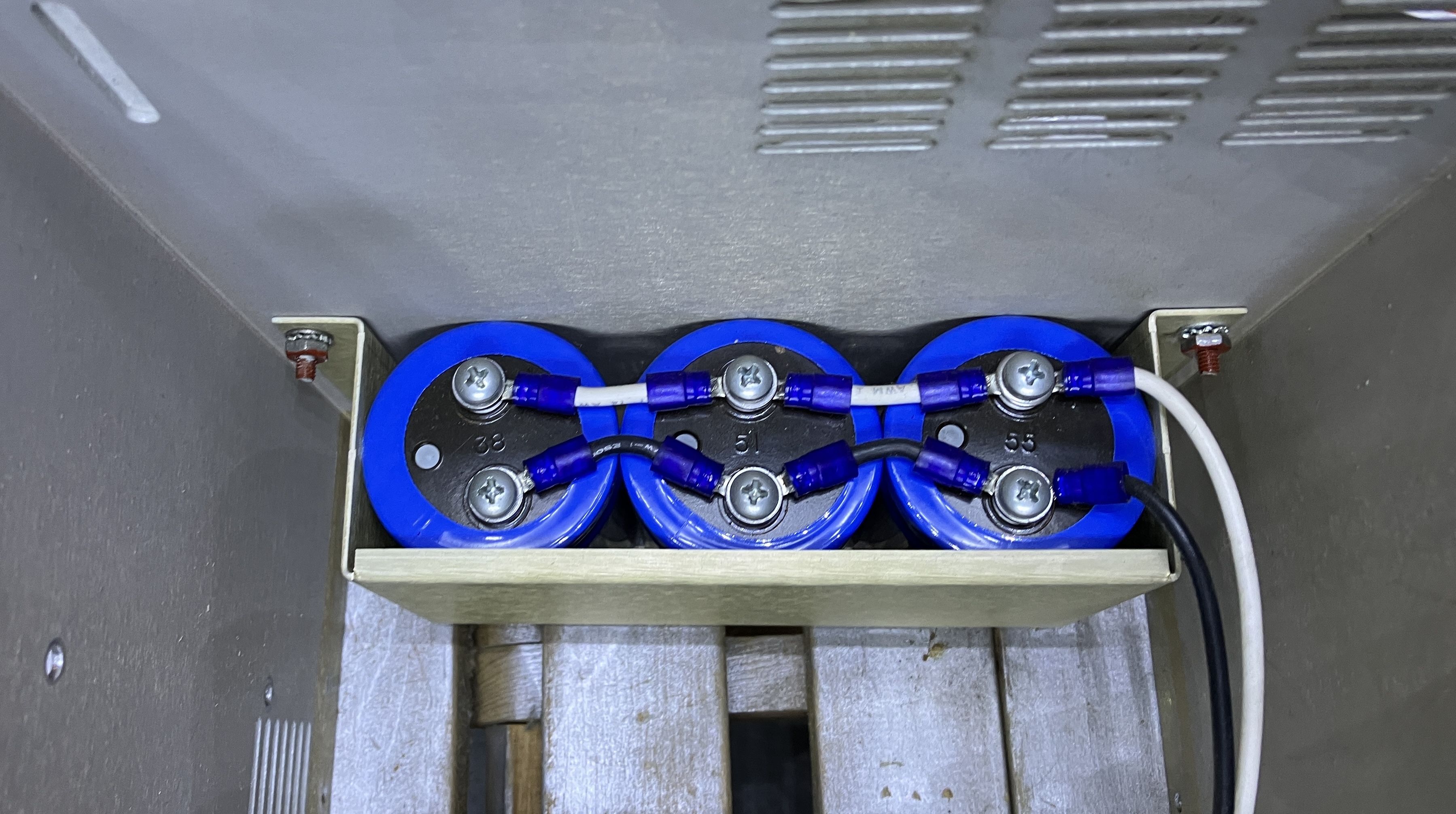
This circuit board contains all of the connections for the front panel as well as some of the high current connections that go to the laser head socket. Take note of the carefully defeated case interlock switch!
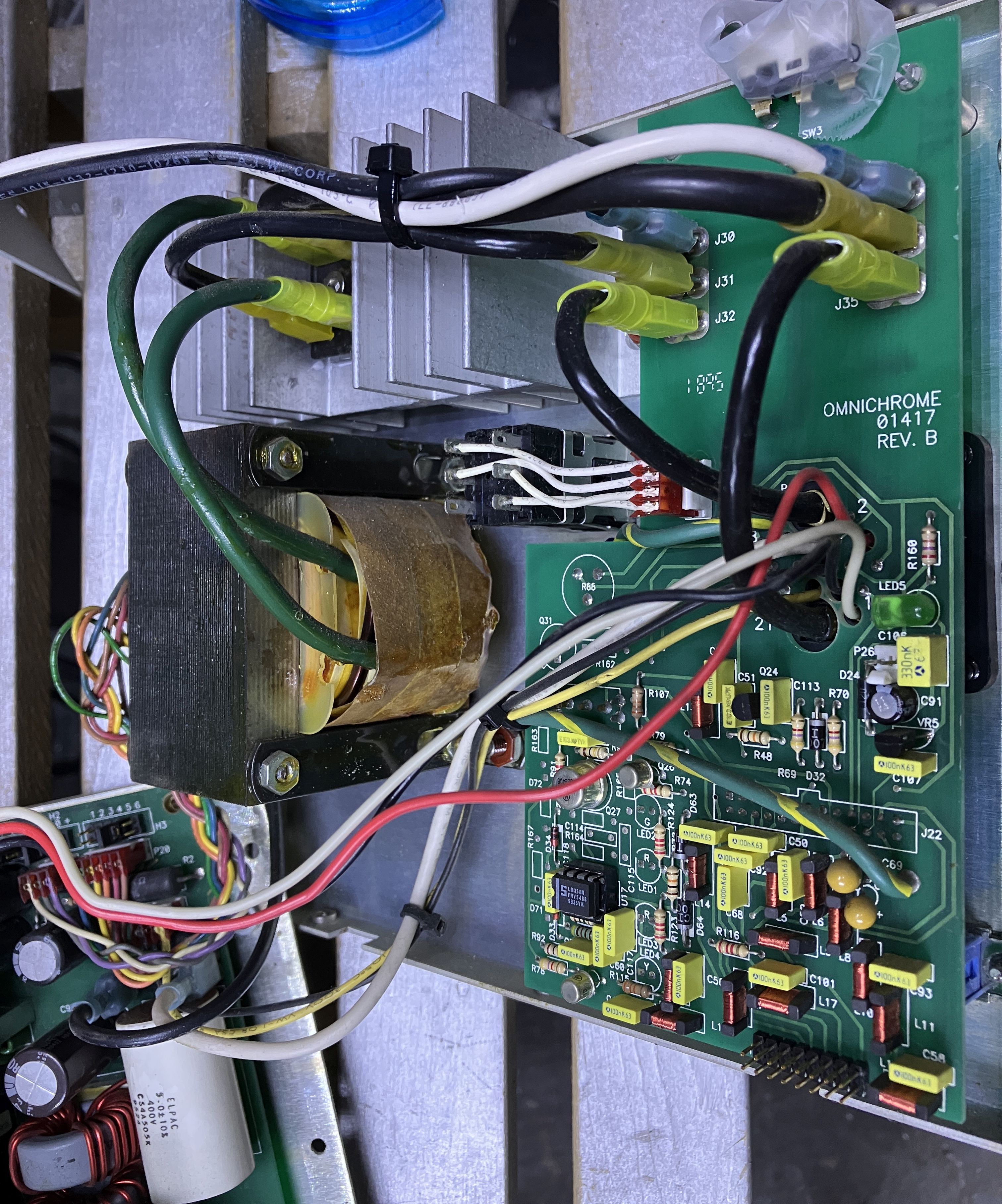
The intended purpose of these jumpers is not entirely clear, but they seem to correspond with several thin, differently colored wires that lead to the transformer mounted to the front of the case. Perhaps this is for selecting different taps on the transformer for the purpose of input voltage range adjustment.
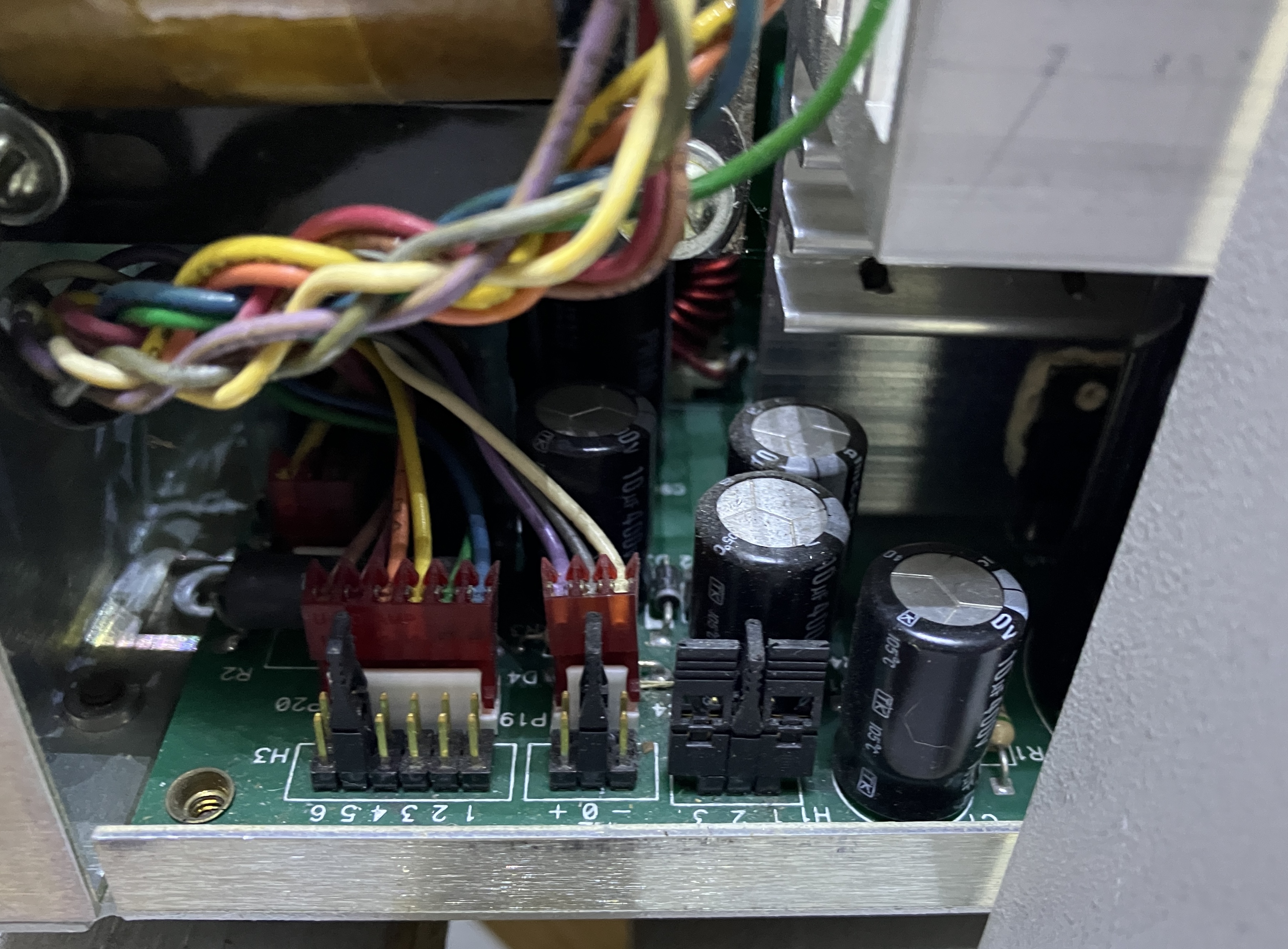
Below is the pin-out for the REMOTE connector of the Omnichrome 171 ion laser power supply.
| PIN |
PURPOSE |
|---|---|
| 1 |
BEAM INTERLOCK OUT |
| 3 |
BEAM INTERLOCK IN |
| 4 |
STANDBY MODE |
| 6 |
CURRENT CONTROL INPUT |
| 7 |
LIGHT CONTROL INPUT |
| 8 |
OUTPUT POWER MONITOR |
| 9 |
TUBE CURRENT MONITOR |
| 11 |
CIRCUIT GROUND |
| 12 | -15 VDC |
| 13 | +15 VDC |
| 17 |
5.1 VDC VOLTAGE REFERENCE |
| 18 |
POTENTIOMETER OUTPUT |
| 19 |
SAFETY INTERLOCK OUT |
| 21 |
SAFETY INTERLOCK IN |
| 23 |
PSOK SIGNAL RETURN |
| 24 |
PSOK +5 VDC |
| 25 | CHASSIS GROUND |
Cooling System
This is the cooling unit for the laser head. A large fan contained within a metal enclosure is connected to the laser head via a duct very similar to a dryer vent tube. As mentioned earlier, the cooling unit forces air through the laser head and exhausts hot air away from it. The cooling unit is powered through a cable that connects to the smaller twist-lock connector on the laser head. Additionally, an interlock circuit does run through the cooling unit which prevents the laser from operating with the cooling system disconnected.
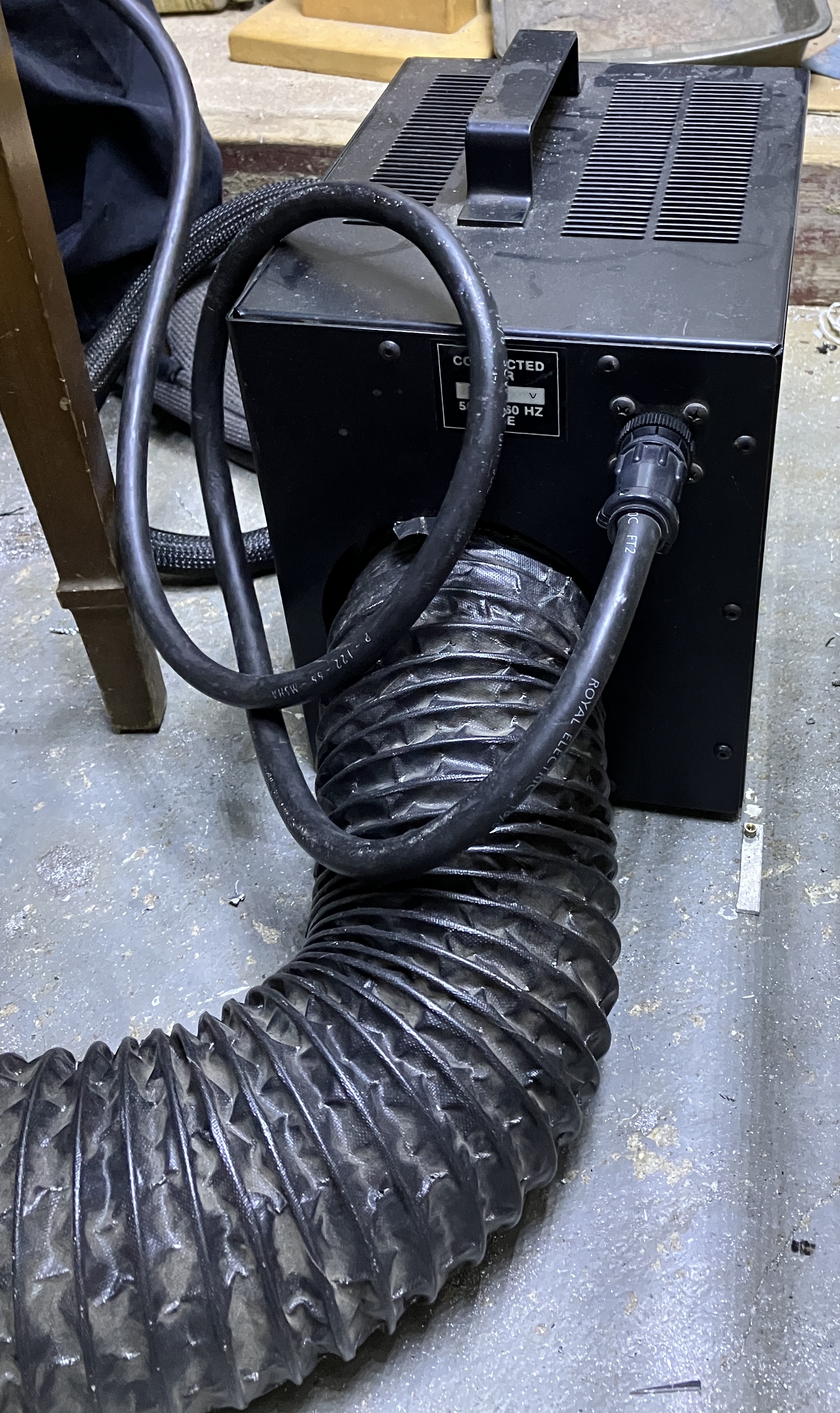

As mentioned earlier, Melles Griot acquired Omnichrome, therefore the manual linked below contains information that is relevant to this laser system. Also, be sure to check out the argon and krypton ion laser page on Sam's Laser FAQ! Many thanks to Zenodilodon for letting us work with and admire this impressive laser system!